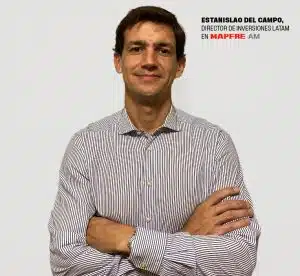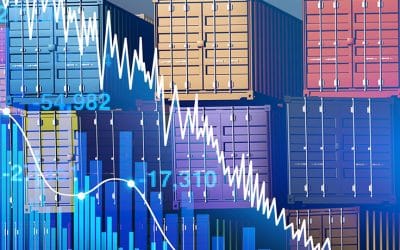Institutional investors in LATAM have become more sophisticated, now resembling their European peers

Redacción Mapfre
In this new edition of "MAPFRE AM's Interview of the Month", with which we show the professional and personal side of the colleagues of the MAPFRE Group's asset manager, we talk to Estanislao Del Campo, LATAM Investment Director at MAPFRE AM. Moreover, we do so at a time when the unit is in the midst of an expansion process in the region:

- How long have you been at MAPFRE? What was your experience joining MAPFRE AM like? Tell us a little a bit about your role.
I've been at the MAPFRE Group for almost 10 years. I started my career here in May 2014, specifically in my beloved MAPFRE Argentina, where I was the Investment Manager. Thanks to one of MAPFRE’s worldwide professional development levers, mobility, as well as to the significant support I received from my family, after seven years in that role, we embarked on the professional and personal challenge of moving to Madrid and starting at MAPFRE AM. I've been here since the beginning of 2021, and I have to say that I really received a warm welcome from my colleagues.
My role consists of facilitating and collaborating in the investment management of our 15 MAPFRE subsidiaries in the LATAM South-Central Region (excluding Brazil) and Mexico, under the leadership of Carlos de Ancos.
My main responsibilities involve analyzing their investment portfolios and associated insurance products, suggesting actions to marry assets to liabilities (Asset Liability Management), searching for investment opportunities in sovereign debt from Emerging Markets for the EU Management Center’s investment portfolios, and detecting opportunities and synergies for MAPFRE AM to grow in LATAM.
I also provide support to our LATAM subsidiaries that I mentioned before, sharing existing best practices from our colleagues at MAPFRE's Corporate Areas as well as from MAPFRE AM.
- How do you structure and limit investment risks for all MAPFRE subsidiaries in the LATAM region at a time when the differences between the developed and emerging economies and their capital markets are growing significantly?
Recently, as part of the eighth edition of our MAPFRE International Investment Day in Toledo, we analyzed a study by economist Carmen Reinhart (*) and other authors, which described the risk/return relationship of foreign sovereign bonds from emerging economies in foreign currency between 1815 and 2016. Over the course of this period, 300 debt restructuring processes/defaults took place, in other words, a simple average of one restructuring process/default every year and a half. Despite this shocking statistic, these types of investments over time in developing economies generated returns that were 400 basis points higher than US and UK sovereign bonds.
With this in mind, it’s important to have a well-defined investment profile, understanding the opportunities and risks that we can and want to tolerate, and investing prudently.
At MAPFRE we employ a conservative investment policy defined in the guidelines as part of the Group's Solvency II, Investment, and Sustainability Policies, among others, as well as an Investment Reference Framework, proposed by the Executive Committee and approved by the Board of Directors at MAPFRE, S.A. Subsequently, each Board of Directors at the subsidiaries must approve it, having adapted it to the insurance investment regulations of each country, requesting exceptions from the Corporate Investment Area if necessary.
(*) Source: https://www.cesifo.org/en/publications/2019/working-paper/sovereign-bonds-waterloo , CESifo, Carmen Reinhart, J. Meyer and C. Trebesch (2019).
- In this volatile and changing world, how are investment policies being adapted and what strategies/guidelines are being given to subsidiaries in the LATAM region?
The Investment Reference Framework, when updated on an annual basis, allows us to remain flexible and adapt to the situation and the most important changes that occur. It reflects the level of risk tolerance, the class of eligible assets, exposures, and specific limits, in addition to other variables. We also have periodic regional investment committees, which constantly reassess market conditions, specific macroeconomic situations and/or political scenarios, and the specific features of the different types of investment portfolios. What's more, at a country level, each one has its own monthly Investment Committee, in addition to other control bodies.
As regards investment strategies, we are recommending reducing reinvestment risk by increasing the average returns of long-term life portfolios in line with the durations and conditions of their liabilities.
This strategy is bolstered by the current context, where almost all Central Banks in LATAM are cutting their interest rates in anticipation of the Fed, the ECB and the Bank of England doing the same. This doesn’t include the Central Bank of Colombia and Mexico, which we believe are very close to beginning to cut interest rates.
- What qualities or differentiating factors would you highlight about the financial centers in the different countries we operate in?
One of the main advantages and assets that we have at MAPFRE subsidiaries are the professional teams and their technical rigor. In the case of Investment Managers, most are locals, meaning not only do they have knowledge of the corresponding regulations and capital markets, but also the culture, the macroeconomic history, and the political idiosyncrasies of their countries. In developing markets, these are important factors to be taken into consideration.
- We recently announced that we’re in the process of expanding MAPFRE AM to LATAM. Why? And how is this being achieved?
Given that MAPFRE is the leader in the Non-Life insurance market in LATAM and bearing in mind our forecast that this market will continue to experience potential growth, for us, growing in this region seems like a natural next step.
What’s more, we boast the support, experience, and collaboration of our subsidiaries that understand their financial markets, the main financial groups, and brokerage firms very well. This lets us contribute to meeting needs, either through our investment products with diversification in Europe or internationally, and/or those related to Insurance, such as Unit-Linked, which we’re specialists in, or administering mandates and discretionally managing investment portfolios.
We're still in the initial stage, and we’ve been pleasantly surprised by the very warm welcome we’ve received in some LATAM countries.
Although we like to be patient with the long-term growth strategy, which is impatient in its execution, we have secured the first underwritings from institutional customers in Colombia and Uruguay for two of our Mutual Funds registered in Luxembourg.
The initial Plan, prepared with our Business Development Manager, Eduardo Ripollés, his Team, and the Management team at MAPFRE AM, consists of making our brand and MAPFRE AM products known in the region as the Management Company of the MAPFRE Group, sharing our important competitive advantages and emphasizing the Group’s values . These values are reflected not only in the day-to-day life of the Management Company, but also in its products, such as ESG Funds, for example.
- Among these products, which ones do you think may be most in demand there?
We're convinced that companies that develop their businesses with strong corporate governance practices and that seek to generate (and measure) a positive impact on the environment and society, will offer better returns in the long term.
Thanks to our ESG Mutual Funds, institutional investors in LATAM could benefit from our own ESG methodologies and the greater regulatory progress made in Europe compared to the region.
As part of the range of MAPFRE AM products, we believe that the Capital Responsable, Inclusión Responsable and Good Governance Mutual Funds will be in highest demand amongst Institutional Customers, whether in EUR or USD.
The first two Funds are Article 8 Funds according to the EU-SFDR Regulation and are ISR certified by the French Ministry of Economy and Finance. These funds are invested in Europe in mixed income and equity, respectively. The Inclusión Responsable Fund is classed as Article 9. The track record of the Capital Responsable Fund is five years while the track record of the Inclusión Responsable Fund is four years.
We have also created our own specific methodology for the analysis and integration of ESG characteristics created by La Financiére Responsable, a French company in which MAPFRE holds a majority stake.
The Good Governance Fund invests in global equities and is working to be considered Article 8. Since its launch two years ago, our Fund Managers, Manuel Rodríguez and Thomas Nugent, have been analyzing companies with a good corporate governance record whose assets are temporarily undervalued by the market. Between the start of 2023 and December 4, 2023, their yield comes to 16.8% in Euros.
- What are the differences between institutional investors in LATAM and Europe? What challenges do LATAM institutional investors face?
I would say that LATAM institutional investors, with a view to capitalizing on lessons from past sovereign debt and balance of payments crises in the region, have gradually become more sophisticated over time, with a view to further minimizing the risks and volatilities in their investments rather than merely searching for and needing returns, quite similar to their European peers.
As for challenges, I think that institutional investors in the region should look at the longer term, continue investing and collaborating so that our societies grow in terms of financial planning and education, and continue developing regional capital markets. I also think that it will be a challenge for companies and investors to adapt to the regulatory progress being made in terms of investments, methodologies, and ESG aspects in the region.
- What are your forecasts for the region and what do you believe are its opportunities?
Our MAPFRE Economic Research Service estimates that Emerging Markets will continue to grow more quickly than developed economies in 2024 (3.7% average versus 0.6% US and 0.7% Eurozone). As regards LATAM, specifically, they estimate average GDP growth of 1.6% for the coming year.
Historically, fixed income in USD in Emerging Markets has tended to perform positively since the most recent rate hike by the Fed and for the following 9-12 months, with some stability in the VIX index, attracting capital to higher risk assets.
For next year, we predict opportunities in LATAM's USD sovereign fixed income in general, given the tailwind that we expect to see caused by the forecast of lower yields in the United States and the depreciation of the dollar.
We think that the countries that are under-represented in the portfolios held by foreign investors in local or global fixed income are particularly appealing and have the potential to offer positive surprises in the improvement of their balances of payments.
We select countries that can generate foreign currency with their exports, whose Congresses aren't composed of automatic majorities so as to reduce risks.
Taking this into consideration, and being even more selective, we prefer countries that have not started or ended their cycle of lowering local rates, such as Colombia and Peru, respectively.
In short, next year will be a challenging and interesting year when it comes to opportunities in the region, with many related factors: presidential elections in El Salvador, Mexico, Panama, Peru, the Dominican Republic, Uruguay, and Venezuela, as well as the United States, minor inflation and lower growth, uncertainty on account of the El Niño phenomenon, and the expectation of almost widespread interest rate cuts. All this in addition to growing geopolitical risks and events.
- Give us a quick summary of your professional experience.
I started my career at the age of 17 at the College of Notaries in Buenos Aires, working there for just over six years in the treasury, accounting, and investment departments. Afterwards, I worked at a family firm managing financial investments and financing for companies in the local market. Before joining MAPFRE Argentina, I supervised the investments, treasury, and payments of an American insurance company in Argentina.
In terms of education, I studied Public Accounting at the University of Buenos Aires and have a master's degree in Finance from CEMA University in Argentina. I also hold the CESGA (Certified ESG Analyst) certificate awarded by EFFAS (European Federation of Financial Analyst Societies). I’m currently a candidate for level II of the CFA (Chartered Financial Analyst).
Hobbies: Playing football with friends and traveling with my family.
Food: Grilling, in particular sweetbreads and provolone cheese
City/country: Bariloche, in the Patagonia region of Argentina. A paradise full of mountains, lakes, and forests.
Music group/singer: It’s difficult to choose just one. My top three are Soda Stereo, Queen, and The Killers.



